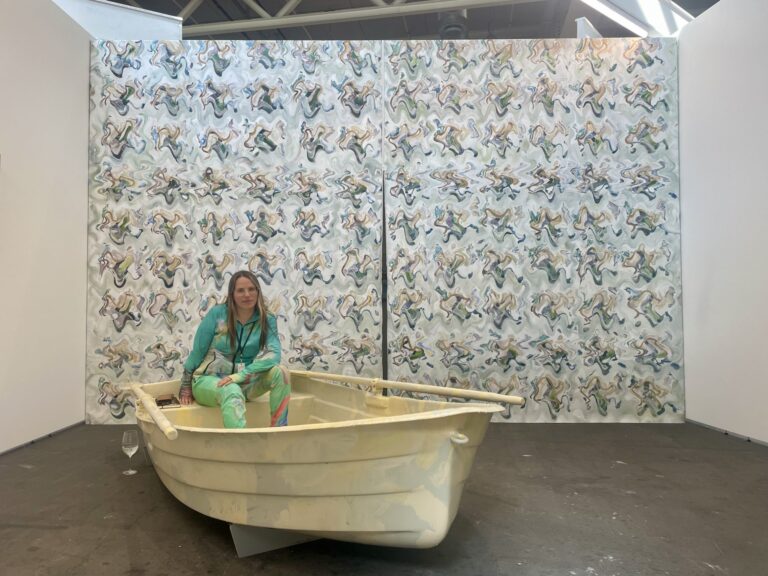For almost three decades, Basel’s List Art Fair has kicked off the most important week on the art world calendar and become a popular venue for young, daring galleries to show cutting-edge work. But this year’s show is looking very safe, suggesting dealers are playing it safe in a tough market.
When the 29th edition of the List opened at 11am today, a crowd of collectors and industry professionals from Europe and Asia, fresh from Zurich Art Weekend or morning flights, gathered. The fair returns to Hall 1.1 of Messe Basel in 2021, relocating from the cramped former Wartec brewery, and is featuring 91 galleries from 35 countries (a slight increase from last year’s 88 exhibitors), including 23 newcomers, including two Seoul galleries, P21 and Cylinder, making their first appearance in Korea, and London’s Rose Easton.
Some exhibitors made sales in the first few hours, but others said sales were slower than usual at a time of global economic and political uncertainty following gains for far-right parties in Sunday’s European elections.
Gallery P21 in Seoul will be showcasing the solo exhibition of Korean artist Kim Ji-yeon for the first time at Liste Art Fair. Photo: Vivian Chou.
The list features paintings and wall hangings throughout, as well as sculptures and small installations, but there are fewer video and kinetic works than in previous exhibitions.
“These are not easy times for galleries,” said Peter Brauer, co-founder of List, which has run the fair since its inception in 1996. This year, the fair decided not to increase booth fees, which start at 6,800 Swiss francs (about $7,600). “The atmosphere is grim,” he said. “There’s a war going on in Europe, but you never know what’s going to happen. There’s always been a crisis, but collectors always buy.”
The fair has undergone a major restructuring over the past year, introducing a new co-director structure: Reto Nussbaum was appointed commercial director in October last year, and Brauer, 72, took over as interim artistic director (despite being retired) after Joanna Kamm stepped down in February.
The fair runs through Sunday, but it seems to already be gearing up for its 30th anniversary edition in 2025. The fair announced today that it has appointed Nicolas Dietrich as its new artistic director, who will take up the post on September 1st. Nussbaum also said that List has decided to stay in Messe Basel, where the booths are arranged in a giant circle. “Most of the galleries prefer this location,” he said. “We decided that by arranging the booths in this democratic way, we could create a space where people could come together.”
Installation view of Margot Sammel’s booth showcasing work by Melissa Joseph. Photo: Vivian Chow.
This may be a year of transition for both the list and the art market, but there’s plenty of art to speak of now. There will be 70 solo exhibition booths, Brauer proudly said. “It’s like 70 little shows. A lot of curators are coming to the fair. It’s a risk for galleries, but it’s also a way to present artists.”
What’s on these artists’ minds? Geopolitical, historical and ecological questions, Brauer says. “Some of the work looks at technology and questions painting as a contemporary medium.”
Kyiv- and Miami-based Voloshin Gallery is presenting a politically charged solo exhibition by Abi Shev (born 1993 in Lezha, Albania). The show includes an animated video installation discovered in an old Albanian prison and a series of sculptures inspired by her father, who fled the communist regime in Greece. The gallery says it has received interest from a range of institutions for the works, which cost between 5,300 euros ($5,700) and 18,000 euros ($19,400).
Beijing and London-based Tabula Rasa is showcasing Taipei and Berlin-based Muskiqi Chih-in’s solo exhibition, “Organology of the World.” His elaborate video installations and drawings address the power dynamics of technology, AI, and the forgotten histories of Afro-Asian communities. The gallery sold several drawings to a collector with a tech background, priced at 2,800 euros ($3,000) each, a fitting location for a work depicting a cross-section of an undersea cable in Mauritian waters.
Temnikova and Casela, visiting from Tallinn, Estonia, are showing work by two Estonian women artists, Edith Karlsson and Flo Casear, who are representing Estonia at this year’s Venice Biennale. Wall hangings and sculptures are priced from 2,900 euros ($3,100) to 25,000 euros ($26,900), and the gallery has sold several pieces in advance, dealer Olga Teminikova said.
Installation view of Yutaka Kikutake’s booth at List Art Fair 2024. Photo: Vivian Chow.
The booth also features small mite-shaped sculptures by Riga-based artist Elina Vitra (a tribute to the country’s recent tick trend), who is presenting a solo exhibition at Liste with Tartu-based Estonian gallery Kogo. Vitra covered Kogo’s booth in canvas, added zippers and turned it into a “walk-in” painting, so that every object in the booth can be read as a painting, according to gallery founder and CEO Lina Laus (even the tracksuit she was wearing was designed by the artist).
“The work is also self-commentary,” says Rouse. “It’s a way of input Painting also means that to be successful, you have to become an “art world insider” – a mantra to live by on a list that continues to set trends and be a key testing ground for emerging talent.
Follow Artnet News on Facebook:
Want to always stay one step ahead in the art world? Subscribe to our newsletter to get the latest news, eye-opening interviews, and incisive critiques that drive the conversation forward.

